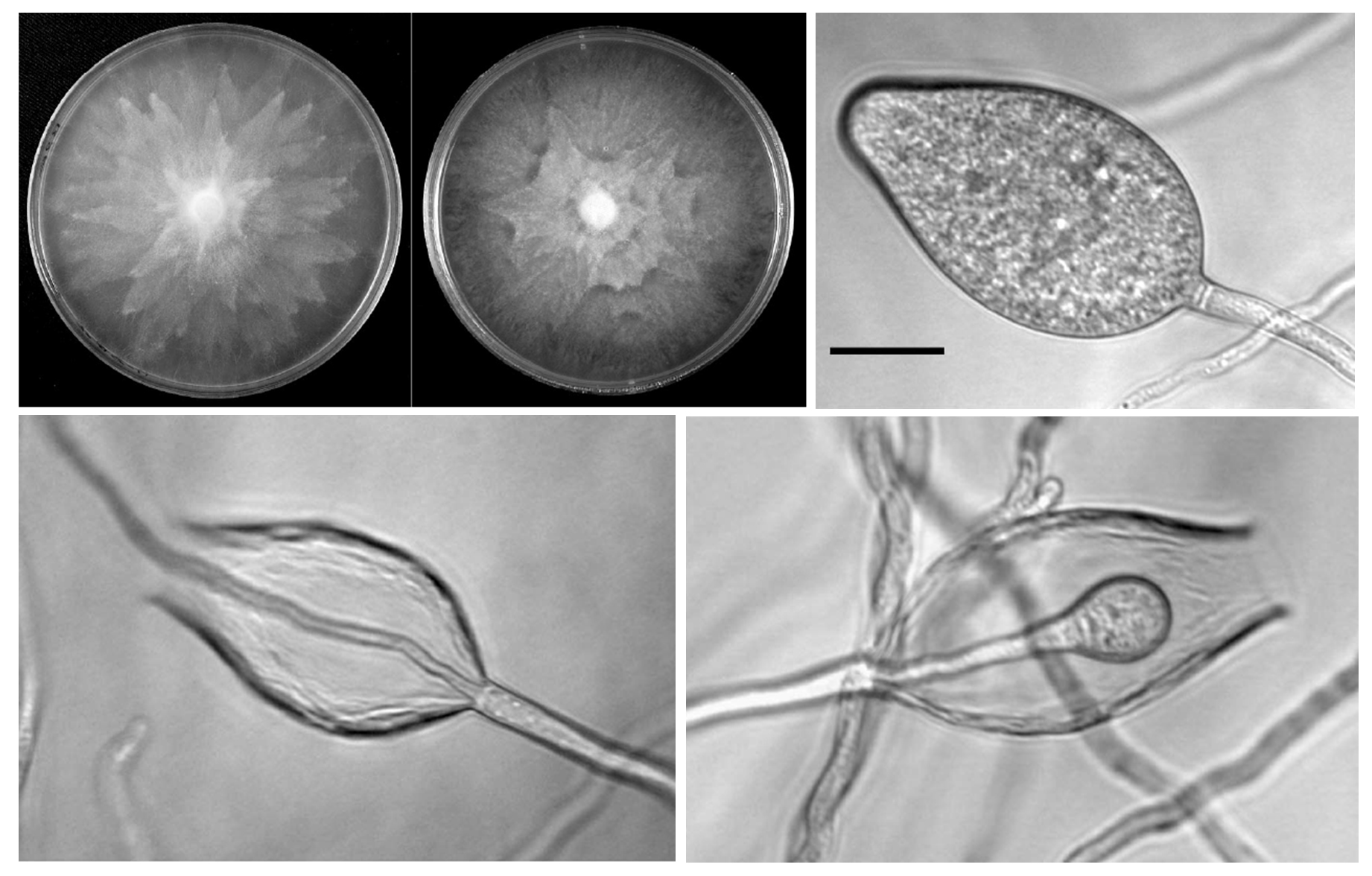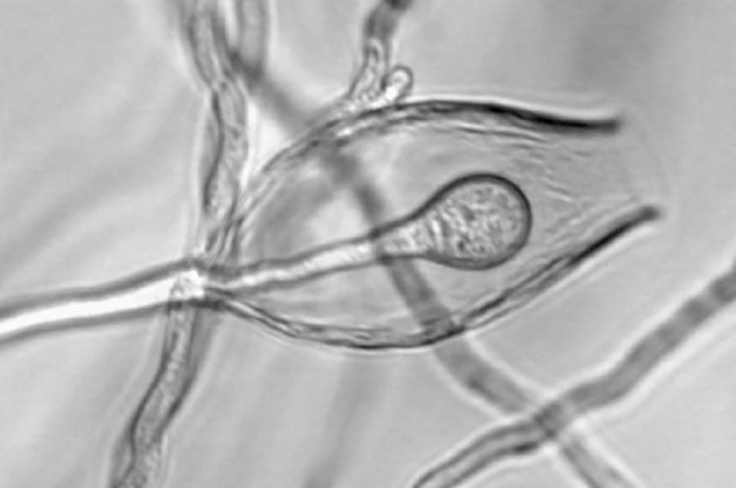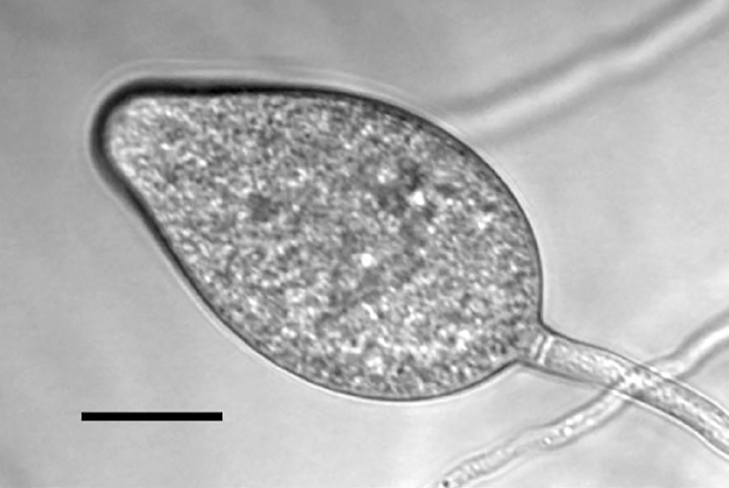Phytophthora riparia
|
Phytophthora spp. in subclade 6d: portion of the seven-loci ML phylogeny featuring the type cultures of 212 described species (by T. Bourret). Notice the position of P. riparia Ex-type CBS 132024 = S&T BL 111. Gloria Abad, USDA S&T.
|
|
Phytophthora spp. in subclade 6d: Morphological Tabular key (PDF) and Tabular key legends (PDF) in IDphy2 KEY SECTION. Notice the data of P. riparia Ex-type CBS 132024 = S&T BL 111. Gloria Abad, USDA S&T.
|
|
Phytophthora riparia (isolate VI 3-100B9F) plates and asexual phase: cultures of V8S (left) and CA (right) at 15 days; nonpapillate sporangia, some exhibiting internal proliferation; Scale bar = 20 μm; photos by Hansen et al 2012. |
|
Phytophthora riparia (isolate VI 3-100B9F): cultures of V8S (left) and CA (right) at 15 days; photos by Hansen et al 2012. |
|
Phytophthora riparia (isolate VI 3-100B9F) asexual phase: nonpapillate sporangium exhibiting internal proliferation; photo by Hansen et al 2012. |
|
Phytophthora riparia (isolate VI 3-100B9F) asexual phase: nonpapillate persistent sporangium; Scale bar = 20 μm; photo by Hansen et al 2012. |
|
Phytophthora riparia (isolate VI 3-100B9F) asexual phase: sporangium exhibiting internal proliferation; photo by Hansen et al 2012. |
Name and publication
Phytophthora riparia Reeser, W. Sutton & E.M. Hansen (2012)
Hansen EM, Reeser PW, and Sutton W. 2012. Phytophthora borealis and Phytophthora riparia, new species in Phytophthora ITS Cladeclade:
a taxonomic group of organisms classified together on the basis of homologous features traced to a common ancestor
6. Mycologia 104: 1133–1142.
Corresponding author: hansene@science.oregonstate.edu
Nomenclature
from Hansen et al. (2012)
Mycobank
Etymology
refers to the streams and adjacent soils of riparian forests where this species is found
Typification
Type: UNITED STATES OF AMERICA, from Oak Creek near Corvallis, Oregon; N44.566593, W-123.300984, collected April 2006, OSC 144,116, dried culture from OSU isolate VI 3-100B9F
Ex-type: MYA-4882 and CBS 132024
Sequences for ex-type in original manuscript: VI 3-100B9F = ITSrDNA HM004225, β-tub JQ626618, Cox1 JQ626632 , Cox 2, 1 JQ626580
Ex-type in other collections
(ET) CBS 132024, ATCC MYA-4882, WPC P19799, S&T BL 111 (Abad)
Molecular identification
Voucher sequences for barcoding genes (ITS rDNA and COI) of the ex-type (see Molecular protocols page)
Phytophthora riparia isolate CPHST BL 111 (= P19799 WPC) = ITS rDNA MG865583, COI MH136975
Voucher sequences for Molecular Toolbox with seven genes (ITS, β-tub, COI, EF1α, HSP90, L10, and YPT1
(see Molecular protocols page) (In Progress)
Voucher sequences for Metabarcoding High-throughput Sequencing (HTS) Technologies [Molecular Operational Taxonomic Unit (MOTU)]
(see Molecular protocols page) (In Progress)
Sequences with multiple genes for ex-type in other sources
- NCBI: Phytophthora riparia CPHST BL 111
- NCBI: Phytophthora riparia 3-100B9F
- EPPO-Q-bank: Phytophthora riparia
- BOLDSYSTEMS: Phytophthora riparia (barcoding COI & ITS)
Position in multigenic phylogeny with 7 genes (ITS, β-tub, COI, EF1α, HSP90, L10, and YPT1)
Clade 6d
Morphological identification
adapted from Hansen et al. (2012)
Mycobank
Colonies and cardinal temperatures
Colony colony:
assemblage of hyphae which usually develops form a single source and grows in a coordinated way
morphology on PDA, V8, and MEA with chrysanthemum pattern. Minimum growth temperature 5°C, optimum 25–30°C, and maximum 35°C.
Conditions for growth and sporulation
Sporangia produced on plugs of culture media flooded in soil extract.
Asexual phase
SporangiaSporangia:
sac within which zoospores form, especially when water is cooled to about 10°C below ambient temperature; in solid substrates, sporangia usually germinate by germ tubes
nonpapillatenonpapillate:
pertaining to the production of a non-distinct, or inconspicuous, papilla at the distal end of the sporangium (cf. papillate and semipapillate)
; persistentpersistent:
pertaining to sporangia that remain attached to the sporangiophore and do not separate or detach easily (cf. caducous)
; ovoidovoid:
egg-shaped, with the widest part at the base of the sporangium and the narrow part at the apex
, obpyriformobpyriform:
inversely pear-shaped, i.e. with the widest part at the point of attachment (cf. pyriform)
(45–65 L x 27–35 W µm); showing nested and extended internal proliferationinternal proliferation:
internal proliferation occurs when the sporangiophore continues to grow through an empty sporangium
; originated in unbranched sporangiophores. Hyphal swellings absent. ChlamydosporesChlamydospores:
an asexual spore with a thickened inner wall that is delimited from the mycelium by a septum; may be terminal or intercalary, and survives for long periods in soil
absent.
Sexual phase
Sterile.
Most typical characters
Phytophthora riparia is characterized by the shape of the sporangiasporangia:
sac within which zoospores form, especially when water is cooled to about 10°C below ambient temperature; in solid substrates, sporangia usually germinate by germ tubes
, the type of proliferationproliferation:
formation of a sporangium within an empty sporangium that has previously emitted zoospores (internal or nested) or after the sporangiophore has emerged from the empty sporangium (external)
, and the sterile character of the sexual phase.
Additional specimen(s) evaluated
Phytophthora riparia ex-type CPHST BL 111, duplicate of P19799 (World Phytophthora Collection)
Hosts and distribution
Distribution: North America (USA: AK, CA, OR)
Substrate: isolated from stream water, riparian soil
Retrieved February 01, 2018 from U.S. National Fungus Collections Nomenclature Database.
Additional info:
Disease note: abundant in stream water, but not overly pathogenic. Not associated with disease in riparian ecosystems.
Hosts: n/a
Additional references and links
- SMML USDA-ARS: Phytophthora riparia
- EPPO Global Database: Phytophthora riparia
- Forest Phytophthora of the world: Phytophthora riparia
- CABI Digital Library: Phytophthora riparia
- Encyclopedia of Life (EOL): Phytophthora riparia
- Index Fungorum (IF): Phytophthora riparia
- Google All Phytophthora riparia
- Google Images Phytophthora riparia
- Google Scholar Phytophthora riparia
Fact sheet author
Z. Gloria Abad, Ph.D., USDA-APHIS-PPQ-S&T Plant Pathogen Confirmatory Diagnostics Laboratory (PPCDL), United States of America.






